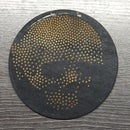Introduction: Scroll Saw Parallel Fence
A scroll saw is a really handy tool. The finest lines and curves can be cut (with practice and patience).
But a simple straight line? Or 10 times the same straight piece?
A parallel fence is not the best idea on such a saw.
The saw-blade is too soft and will go its own way anyway.
Well, that's also true. But it works very well on softer woods or plastic.
My proxon doesn't offer an option for such an extension out of the box.
So i built one.
Step 1: First Measurments
I still had guide rails left over from a table for a router.
They are also ideally suited for such a project.
Since the table of the saw is made of aluminum, it should be relatively easy to screw something on here.
- But aluminum also means that you should not screw too tightly.
- Double-sided adhesive tape is always helpful for pre-positioning.
So at first just cut a piece of your guide rail, take a screw and wingnut and some wood.
Just to get an idea ot the finished project.
Step 2: Attach Guide Rail
To hold it in position, i've used double-sided tape.
Select two suitable screws and start with a very thin drill bit.
I didn't have any screws with an extremely flat countersunk head, so I put two screws on the left side. this works, but it would be better to have one screw on the left and one on the right. when the position for the screws is found (attention! also look behind the aluminum plate of the saw), then pre-drill two holes (1.5mm). Now you have everything you need. In the aluminum plate of the saw you can now set the threads with a tap. In the guide rail, a hole must be approximately as large as the diameter of the screw. The other hole must be as large as the tool with which you want to insert the screw.
Step 3: The Parallel Fence
In the photo you can see the sled from below.
It is very important to also have a piece of wood at the front of the sled. This keeps the sled straight. The hole for the fixing screw should be made as precisely as possible. It should be as centered as possible and slightly larger than the screw you are using.
Step 4: Test and Correct If Necessary
For the test I used 3mm multiplex birch.
It fit directly on the first try. I then directly made 10 of those. All have become identical.
You should round off the rail a little at the ends so that you do not get stuck.
A variant with a fence that can be installed at an angle makes no sense.
Always remain straight to the saw blade.
After all... this is one of my favourite tweaks in my shop.
My next step will be a light. Integrated directly into the arm.
Thank you for reading,
if you like this project, feel free to vote :)

Participated in the
Jigs & Rigs Speed Challenge













